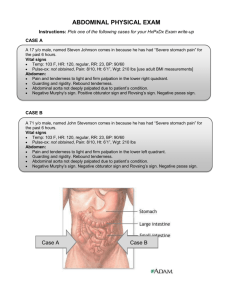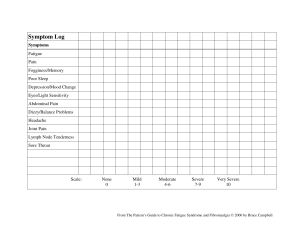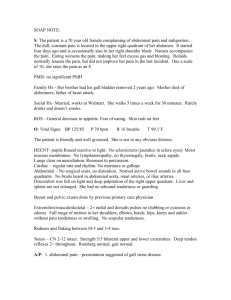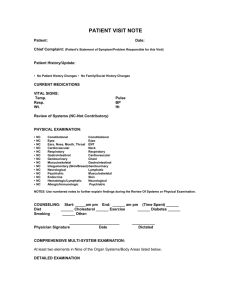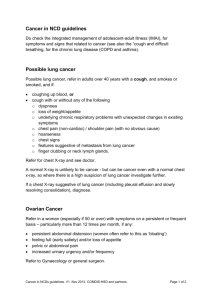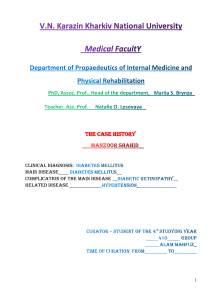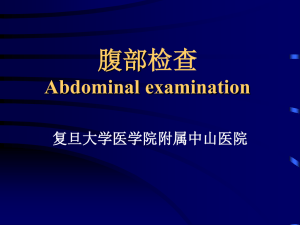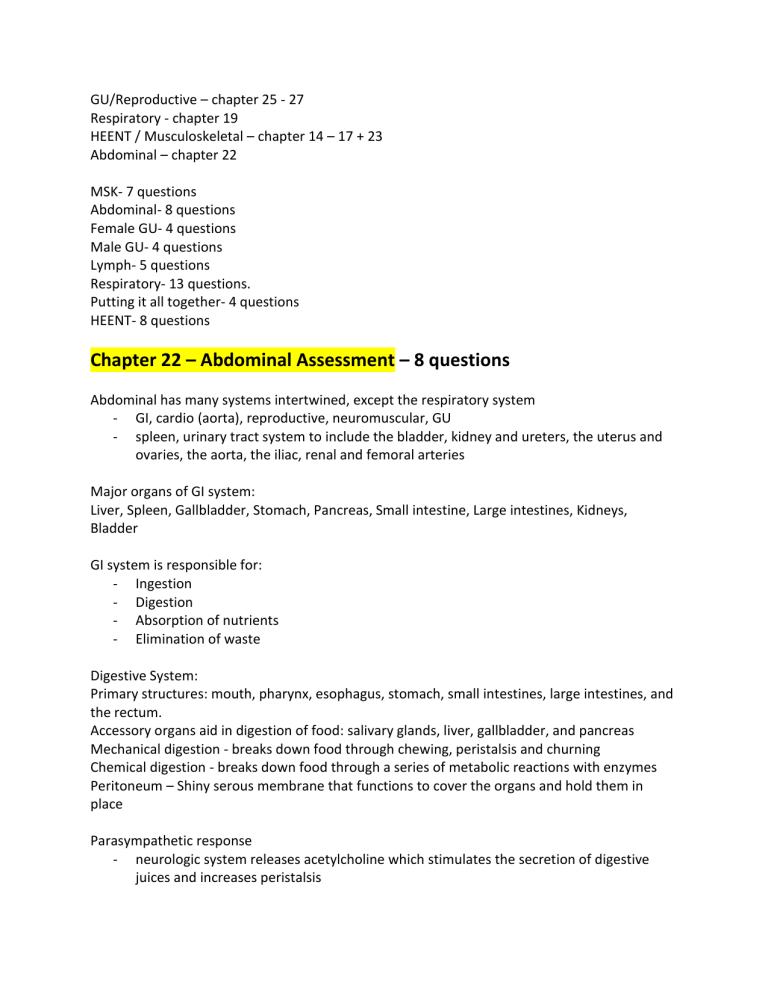
GU/Reproductive – chapter 25 - 27 Respiratory - chapter 19 HEENT / Musculoskeletal – chapter 14 – 17 + 23 Abdominal – chapter 22 MSK- 7 questions Abdominal- 8 questions Female GU- 4 questions Male GU- 4 questions Lymph- 5 questions Respiratory- 13 questions. Putting it all together- 4 questions HEENT- 8 questions Chapter 22 – Abdominal Assessment – 8 questions Abdominal has many systems intertwined, except the respiratory system - GI, cardio (aorta), reproductive, neuromuscular, GU - spleen, urinary tract system to include the bladder, kidney and ureters, the uterus and ovaries, the aorta, the iliac, renal and femoral arteries Major organs of GI system: Liver, Spleen, Gallbladder, Stomach, Pancreas, Small intestine, Large intestines, Kidneys, Bladder GI system is responsible for: - Ingestion - Digestion - Absorption of nutrients - Elimination of waste Digestive System: Primary structures: mouth, pharynx, esophagus, stomach, small intestines, large intestines, and the rectum. Accessory organs aid in digestion of food: salivary glands, liver, gallbladder, and pancreas Mechanical digestion - breaks down food through chewing, peristalsis and churning Chemical digestion - breaks down food through a series of metabolic reactions with enzymes Peritoneum – Shiny serous membrane that functions to cover the organs and hold them in place Parasympathetic response - neurologic system releases acetylcholine which stimulates the secretion of digestive juices and increases peristalsis Sympathetic response -norepinephrine is released, which decreases peristalsis and secretion of digestive juices. The endocrine system through the pancreas releases insulin, glucagon, and gastrin to assist with carbohydrate metabolism and the release of bicarbonates and pancreatic enzymes into the duodenum to aid in the digestion of proteins, fats and carbohydrates. Infants and toddlers for example, have a higher incidence of hernia than older children. Preschoolers are more likely to develop parasitic infections teenagers more likely to develop abdominal concerns related to pregnancy, sexually transmitted diseases, eating disorders or infectious mononucleosis Appendicitis occurs more frequently in children and teenagers. Older adults may have problems with their teeth, affecting their ability to chew. There is often a reduction of saliva, stomach acids, gastric mobility and peristalsis, which can cause problems with swallowing, absorption, and digestion. Constipation is common in the older adults. The liver becomes smaller and the function declines making it harder to process medications. There also may be a diminished response to painful stimuli which may mask abdominal aliments. Older adults may have trouble assuming some positions necessary for exams, so modifying positions becomes imperative for comfort. Sickle cell anemia, which results in abdominal pain and vomiting, is seen almost exclusively in African Americans. - This population tends to have a higher incidence of obesity and lactose intolerance, which may cause abdominal cramping and diarrhea. -Asian Americans have a higher incidence of gastrointestinal cancers. -Jewish Americans have a higher incidence of lactose intolerance, Crohn’s disease which often causes abdominal pain and diarrhea; ulcerative colitis which results in abdominal pain, diarrhea and bleeding; and colorectal cancers -Native Americans have a higher incidence of alcoholism with related jaundice, ascites and pain; diabetes resulting in polyuria, thirst and weight loss; and gallbladder disease resulting in pain. Pediatric Considerations: Stomachache is a common complaint Pot-belly appearance Normal in infants and toddlers when standing Disappears with lying down Use distraction with abdominal palpation Inquire on appetite and fluid intake with any illness!!! Geriatric Considerations: Pain sometimes absent or minimal Organs and masses easier to feel (Due to less muscle tone and bulk) Fever less likely with infection Prone to dehydration Assess fluid intake and appetite Past Medical History: Assess: Previous abdominal problems – stomach ulcers, hemorrhoids, hernia, bowel disease, cancer, hepatitis, cirrhosis, appendicitis, lactose intolerance, food allergies Abdominal surgeries Appendectomy Cholecystectomy Hysterectomy Difficulties: Problems with swallowing, heartburn, nausea, yellowing of skin, gas, bloating, vomiting. Pertinent History: Current Medications Don’t forget about: NSAID’s, Tylenol, herbals, iron and calcium Risk Factors Alcohol or Substance Abuse Foreign Travel Lifestyle ** NSAIDS affect the liver, Most Common Abdominal Complaints Pain Weight changes Change in Bowel Patterns Indigestion Nausea Vomiting Urinary/renal symptoms ** rapid onset = serious problem! Three types of abdominal pain Visceral - distention/stretching “burning, cramping, diffuse and poorly localized” Parietal inflammation of the parietal peritoneum “severe, localized, aggravated by movement” Referred – at site away from structure that shares a common nerve path Note location, duration, quality and severity of the pain using a recognized pain scale Pain History Indigestion or “heartburn” Usually described as burning, worse after eating Indigestion increased when lying flat = hiatal hernia or GERD Indigestion associated with belching and flatulence = cholecystitis or gallbladder disease Abdominal pain Chest or flank pain Fever or chills (+ or -) Weight Changes Unexplained Sudden weight gain Eating Disorders Diet Cathartics Exercise Purgatives ** Sudden weight change of more than 2 to 3 pounds in a 48 hour period is usually indicative of fluid loss or retention. ** Unexplained weight changes in a patient can be a sign of many things including: gastrointestinal disease, cancer, congestive heart failure, metabolic and endocrine disorders, unhealthy lifestyles, major depression, and eating disorders. Change in Bowel Patterns Diarrhea Frequency Presence of blood or mucus Precipitating factors Bowel patterns Change from norm Frequency o Constipation or straining Color and character of stools Use of laxatives Nausea and Vomiting – caused by stress on stomach wall or esophagus Assess for: Frequency Characteristic Undigested food Green Bloody Coffee Ground Projectile Aggravating Factors Medication Food/allergies Alcohol consumption ** projectile vomit in infants = pyloric stenosis Adults = alcoholic or esophageal varices; it can also be observed in patients with head trauma. Urinary/Renal Symptoms – GU complaints “plumbing problems” - Urinary heszitancy - Discolored urine - Dysuria - Hematuria - Polyuria - Nocturia - Back/flank pain – kidney or msk - Discharge – std - LMP – always rule out pregnancy Assessment: Health History Inspection Size, shape and symmetry Symmetrical Scaphoid, flat, round, or protuberant Distention Fibroid Flatus Full bladder False pregnancy Fat Fluid Feces Fetus Fatal tumor Look for Scars, striae, lesions and drains, etc. Aortic pulsations Bulging Peristaltic (gastric) waves Ascites Hernias (umbilicalk hernia is common in infants and young children) Non-distended is normal Generalized or localized Auscultation - Always listen before you percuss or palpate when assessing the abdomen. Always auscultate before palpating. Bowel Sounds Normal findings Normo-active bowel sounds Occur every 5 to 15 seconds 5 to 34 per minute Document as +BS or Active BS Measure rate in RLQ one full minute Absent bowel sounds Listen for at least 5 minutes to verify Hypoactive bowel sounds – opiates, peritonitis, obstruction, postop due to anesthesia < 5 per minute Hyperactive bowel sounds – IBS, bowel infection, diarrhea, paralytic ileus, laxatives > 34 per minute Listen with diaphragm High pitched gurgles or clicks Last one to several seconds Assess frequency and location Listen in all 4 quads Start in RLQ over the ileocecal valve to the right of the umbilicus RLQ is an active area that connects the small intestines to large intestines Percussion Liver Normal span 6-12cm @ right midclavicular line Spleen Normally tympany heard If dullness heard indicates enlargement Bladder Costovertebral Angle (CVA) Kidney tenderness Palpation Light palpation only in all 4 quadrants Detection of firmness and tenderness Normally soft vs. full, firm or rigid Note degree of tenderness Minimal, moderate or marked Note any guarding, rigidity or nonverbal signs of pain Observe nonverbal cues Abnormal findings Tinkling – air in distended bowl Rushing sound – partial intestinal obstruction Friction rubs – liver tumor or peritoneal inflammation Listen over liver and spleen Listen with diaphragm Resembles grating sounds Vascular sounds Listen with bell o Bruits in hepatic area = liver cancer or alcoholic hepatitis o Venous hum = partial obstruction of an artery and reduced blood flow to organ Assessment Terms: - Ascites (500mL) o Fluid accumulation in peritoneal cavity o Look for shifting dullness or fluid wave o Measure daily weight and abdominal girth measurement - Rebound or referred tenderness o Both indicate peritoneal inflammation o Example: Appendicitis - McBurney’s sign Rebound tenderness in RLQ Positive for appendicitis CVAT Costovertebral angle tenderness Location - Flank area Kidney tenderness - possible infection Kehr’s Sign Movement of arm upwards – referred pain to left shoulder Positive for splenic injury, renal calculi or ectopic pregnancy Murphy’s Sign Palpate at RMCL under costal angle Positive for Cholecystitis and carcinoma of gallbladder Chapter 19: Respiratory – 13 questions Lobes of the Lungs: - Right lung is shorter than left. - Right lung has three lobes, Left lung has two - Lobes are separated by sloping segments (fissures) - Right lobe horizontal & oblique fissure - Left lobe oblique fissure - Posterior chest wall is mainly all lower lobe - Anterior chest is mainly upper and middle lobe - L lung has no middle lobe Trachea and Bronchi- Constitutes dead space- filled with air which is not available for gas exchange, but transports gases from the environment to the bronchioles, alveolar ducts, alveolar sacs and alveoli. Alveoli- exchange of oxygen and carbon dioxide R main bronchus is shorter, wider and more vertical than L Chest/Thorax - AP/LA ratio Symmetrical Antero-posterior diameter (AP) - Approximately ½ the transverse diameter AP/LA ratio 1:2 Chest/Thorax Abnormalities Barrel Chest: AP-Transverse diameter-equal Hyperinflation of lungs- Due to normal aging, chronic emphysema & asthma. Scoliosis: Thoracic & Lumbar spine have S-Shaped curvature Mild deformities are asymptomatic. >45 degree deviation- decreased lung volume. At risk for cardiopulmonary fxn. Kyphosis: Humpback (exaggerated curvature of thoracic spine) Associated with aging “dowager’s hump”- postmenopausal, osteoporotic women Infants & Children - Head circumference is slightly larger than the Chest circumference until 2yrs. of age. - Antero-posterior diameter (AP) - AP diameter-Rounded thorax, - AP is equal to transverse chest diameter. - By 6yrs. Of age, thorax reaches adult ratio of 1:2 AP to transverse ratio. - Thin chest wall, ribs and xiphoid process are prominent. - Obligate nose breather until 3months of age. - Breathing is diaphragmatic & abdominal o Abdominal muscles help pull diaphragm down to fill with air Abnormal Findings - Flaring of nostrils - Sternal or intercostal retractions (pictured) - Tachypnea (RR 50-100 breaths/min.) - Asymmetric expansion - Decreased breath sounds Respiratory System’s Four major functions - Supplies oxygen- for energy production - Eliminates Carbon Dioxide- waste product of energy reactions - Maintains homeostasis- Acid-Base balance - Maintains heat exchange Developmental changes of the lungs & Thorax • Older Adults • Decreased respiratory muscle strength • Decreased lung elasticity • Calcified costal cartilages • Pregnancy • growing uterus displaces the diaphragm. • Increases maternal oxygen demand • Lung Cancer • Leading cause of death in the United States • Smoking is the leading cause of lung cancer Culture and Genetics • Foreign born & Racial/ethnic minorities large incidence of Tuberculosis. • Allergic Asthma- interaction between genetic susceptibility and environmental factors. The Health History-Subjective • Common or concerning symptoms • Shortness of Breath • Chest Pain • Cough • Congestion • Respiratory Infections • Environmental exposure • Smoking History The Health History-Objective • Abnormal breathing pattern • Intercostal retractions • Adventitious lung sounds • Retractions • Skin color • Accessory Muscle use • Anterior/Posterior shape • 6 minute walk test (6MWT)- measures respiratory function of older adults • Lung Sounds • Auscultate all fields • Anterior • Posterior • Axillary • Auscultate in a systematic manner • Ask patient to breathe through the mouth a bit deeper than usual. • Compare one side to the other • Listen to one full respiration at each spot (inspiration & expiration • Please remember: Auscultate a minimum of 10 sites- 2 (4 total) anterior, 6 (12 total) posterior, 2 (4 total) axillary. Respirations: • Three types of normal breath sounds: • Bronchial (Trachea & Larynx) • Quality- Harsh, hollow, tubular • Bronchovesicular (Over major bronchi) • Quality- Softer than bronchial sounds, tubular quality • Vesicular (Peripheral lung fields) • Quality- Rustling sound/breezy • • - Breathing Pattern • Normal: 10-20 BPM • Depth- 500-800ml • Pattern- Even • Tachypnea: >24 BPM • Shallow & rapid breathing • Cheyne-Stokes: • Regular pattern of increased rate and depth of breathing, mixed with periods of apnea • Hypoventilation • Irregular, shallow pattern • CO2 buildup • Hyperventilation • Increased rate & depth • CO2 blown off Abnormalities • Cough • Acute cough: <2-3 weeks • Chronic cough: >2 months • Dyspnea • How much activity precipitates Shortness of Breath • Hx. Of respiratory infections • Smoking hx. • Environmental exposures • Congestion • Accumulation of fluid or secretions in the lungs. • Impairs gas exchange Increased work of breathing • Retractions- Area between ribs and in the neck sink in when patient breathes in. • *Typically seen when trachea and or bronchioles were partially blocked. Use of accessory Muscles- contraction of the sternocleidomastoid and scalene muscles upon inspiration. • * Assoc. with severe obstructive diseases. Accessory Muscle Use / Intercoastal Retractions: Neck & shoulder muscles used to assist breathing. Muscles between ribs pull in during inspiration Possible etiology: copd, asthma in exacerbation, secretion retention, indicates severe respiratory distress and hypoxemia Adventitious Lung Sounds • Fine Crackles- Inspiratory, high-pitched, popping, not cleared with coughing. • Rales, fluids in lungs – lower lobe • Course Crackles- Low pitched gurgling & Bubbling heard during early inspiration, may clear with coughing. \ex CHF, PNA • High-Pitched wheeze (Sibilant)- Predominately in expiration, polyphonic sound • Low-Pitched wheeze (Sonorous rhonchi)- Heard during inspiration & expiration, monophonic, snoring sound, may clear with cough. • Middle L lung • Stridor – heard over the trachea due to airway obstruction • Rhonci – upper lobe, obstruction or fluid in lartger airways • COPD, PNA Palpitation of Posterior chest: • Confirm Symmetric Expansion • Place hands sideways on posterolateral chest wall with thumbs pointing together at level of T9 • With Deep breath, thumbs should move apart symmetrically Tactile Fremitus – “99” vibration • Sound generated from larynx, transmitted to chest wall= Vibration • Palpable Vibration • Symmetry is critical • Decreased fremitus = excess air in lungs, increase thickness of chest wall • Increased fremitus = lung consolidation • • Bronchophony Pt. repeats “ninety-nine,” while you listen with stethoscope over the chest wall. • Normal finding: • Muffled, soft voice, indistinct words • Abnormal finding: • Words are more distinct than normal, clearly hear “ninety-nine,” sounds close to your ear. • Indicates lung consolidation Egophony Have patient phonate a long “ee-ee-ee” sound, while auscultating the chest wall. • Normal Finding • Hear “eeeeeeeeeee” through stethoscope • Abnormal Finding • Over areas of compression or consolidation, “eeeeeeee” sound changes to “aaaaaa” sound. • • • • • • • • Whispered Pectoriloquy Ask patient to whisper “one, two, three,” while auscultating the lungs. • Normal Finding • Mostly inaudible, faint, muffled voice • Abnormal Finding • With small amounts of consolidation, soft voice is heard clearly and distinctly- as if the patient is whispering into the stethoscope. Percuss Posterior Chest Sound over Lung fields Resonance- low pitched, hollow, clear sound found in healthy lung tissue. Flat- Dull sound, heard over solid areas (bones) Dull- Heard over dense areas, such as tissue (organs) Respiratory System Health Promotion Effects of smoking and 2nd hand smoke Avoid harmful environmental factors (dusts, chemicals, etc.) Promotion of health- Helps maintain or improve quality of life, decreases chances of premature death and of disabling illnesses. HEENT / Musculoskeletal – chapter 14 – 17 + 23 HEENT- 8 questions, Lymph – 5, MSK – 7 • • • • • Head Eyes Ears Nose and Sinuses Throat, Mouth and Neck Head - protects the brain, evaluate that within the neuro system Nose - begins the respiratory tract and creates our sense of smell sinuses - lighten the weight of the head and gives resonance to our voice mouth - begins the GI tract and also provides communication for the body eyes - provide vision, with the ears providing hearing thyroid - provides metabolism and helps to regulate calcium and phosphorus cervical lymph nodes - help to fight infections. • Head, Neck and Face S&S • Head pain • Headache • Jaw tightness or pain, tooth pain • Neck pain or stiffness, neck mass • • • Nasal congestion, nose bleeds • Mouth or dental pain, lesions • Sore throats or hoarseness Eyes S&S • Vision changes • Eye tearing or dryness • Eye drainage • Eye appearance changes Ear S&S • Hearing loss • Vertigo (dizziness) • Tinnitus (ringing in ears) • Ear drainage (otorrhea) • Earache (otalgia) • Includes all four assessment techniques • Inspection ( throat and internal nose can only be inspected) • Palpation • Percussion (sinuses can only be percussed) • Auscultation ( vessels in neck & thyroid can only be auscultated) • Usually includes cranial nerve assessment • Head Physical Assessment includes • Inspection • Shape ( rounded with no signs of abnormality or unusual curvature) • Symmetry (nasolabial fold & palpebral fissure) • Can be affected by CVA, TBI, damage to cranial nerve VII, facial nerve (Bell’s palsy) • Movement • Palpation • Skull • No tenderness or soft areas • Note deformities • Open fontanels in newborn Facial Bones • Should be firm w/o tenderness • TMJ for crepitus and tenderness • Assess head and face • Size • Shape • Symmetry • Movement and position • Inspect scalp for lesions, scaling, tenderness, masses and bugs Infant head size: • Normocephalic – normal 33 -37 cm (average is 34 cm for infant & 57 cm for adult) • Bulk of growth occurs by age 2 • Microcephalic – abnormally small head • Usually means brain has not developed properly • Can lead to developmental delays, retardation, problems with speech and motor development • Macrocephaly – abnormally large head • Not an abnormality, normally passed down through generations Abnormal facial structures: • Changes in skin color • Edema – periorbital or across cheeks • Full face – Cushing’s syndrome • Periorbital - sinusitis • Tics – neuro issues • Excessive Blinking • Grinding of the jaw – TMJ Eyes Physical Assessment includes: • Inspection Lids (also palpate) Lashes (also palpate) Eye position / symmetry Conjunctiva Normally clear Mucous membrane that lines the eyelids Sclera White in Caucasian / light skin Muddy appearance in darker skin Jaundice (yellow) – liver disease Ophthalmoscope After pupils are dilated Darkened room Allows visual inspection of the veins and arteries Evaluate optic disk and macula ( macular degeneration in diabetics) • Palpation • Visual Acuity with Snellen Chart Cover one eye, then the other, then both eyes • 20/20 – first number is distance from chart • Second number is distance at which a normal eye could have read that line - OU – both eyes OD – right eye OS – left eye • Always record if tested with correction (cc) CC 20/20 – corrective lenses Visual fields (peripheral vision) EOM’s – check 6 ocular movements (CN 3, 4, 6) – both eyes should move together Pupil response to light and accommodation Direct and consensual pupil response Abnormal eye findings: • Exophthalmos – protruding eyes • Thyroid condition (hyper, Graves’ disease) • Enophthalmos – sunken eyes • Congenital problem, abnormality, trauma • Horner’s or sinus syndrome • Allergic shiners • Bluish appearance under eyes • Venous congestion, chronic allergies • Arcus Senilis – white or gray opaque ring in corneal margin (present at birth then fades) • Bluish arc • Common in elderly • Hypercholesterolemia Common Eye Terms: • Cataract – clouding of the lens • Glaucoma – pressure damage to the optic nerve • Second leading cause of blindness • Myopia – nearsightedness • Hyperopic - farsightedness • Presbyopia – aging vision • Ptosis – eye droop • Conjunctivitis Ears Physical Assessment includes • Inspection • size, shape, position, discharge, lesions • Palpation • tenderness, any lesions • Gross hearing acuity – normal voice, whisper test, Weber and Rinne • Inspecting inner ear (behind tympanic membrane) – use otoscope • • • - External Ear • Inspection • Auricles • Piercing • Lesions or keloids • Scaliness • Palpation • Tragus • Note if any tenderness (sign of infection) Internal ear • Check for redness, swelling, discharge, foreign bodies, cerumen (ear wax) Tympanic membrane (eardrum) • Check with Otoscope • Translucent with pearly gray color • Flat and Intact Abnormal Ear Findings: Tympanic Irregularities o Otitis media – red & inflamed (pediatric ear ache) o PE Tube – (pressure equalizing inserted to prevent ear infections by allowing drainage Nose & Sinuses Physical Assessment includes • Inspection • Nose – mucous, discharge (clear or purulent) , patency (important for children who may put things in their nose) • Symmetrical and midline • No inflammation • Nares • Note flaring or audible congestion (abnormal) • Clear or purulent • Palpation • Nose – along sinuses for tenderness • At birth, only the ethmoid and maxillary sinuses are fully developed • All other sinuses are developed by age 7 • Percussion – one organ we can percuss for tenderness over the frontal and maxillary sinuses • Inspect color of mucosa, presence of discharge, patency • Palpate tenderness • Percuss for tenderness over frontal and maxillary sinuses Mouth & Throat - Physical Assessment includes • • • • • • • Inspection • Lips – color, moisture, lesions/cracks • Pharynx • Note color and condition • Normally pink and clear • Note redness, exudates or drainage • Palpation Inspect and palpate lips, tongue, oral cavity, tonsils, pharynx (color and moisture), teeth, breath, presence of exudate, erythema, lesions, palate Oral Mucosa & Gums Inspect color, condition and lesions Gums - note any gingiva, bleeding, retraction or hyperthrophy • Normally pink, patchy pigmentation in darker skin • Should be moist Abnormal findings • Painful, reddened • Small painful vesticles • Lichen planus – chronic gray, lacy patches • Erythroplakia – reddened mucosa changes • Leukoplakia – white patchy lesions • Often seen in smokers and is often precancerous • Lesions/sores Teeth • 32 teeth in adult mouth • Note if decay, missing or loose fillings • Note if dentures • Proper fitting or loose Tongue • Should be pink and even • Dorsal surface rough with papillae • Thin white coating • Ventral surface should be smooth, glistening, showing veins • Saliva present • Normal movement Abnormal findings • Color changes • Reddened, smooth, painful • Red, beefy tongue – pernicious anemia • Ulceration/lesions • Black hairy tongue – fungal infection • Tonsils – in nasal pharynx, acts as filter against disease • Note size and condition • Mononucleosis, leukemia, diphtheria – white membrane covering tonsils • Normally clear if visible • Note any redness or exudates • Graded 1-4 • 1+ Barely Visible • 2+ Halfway between tonsillar pillars • 3+ Touching Uvula • 4+ Touching each other (kissing tonsils) (MONO) • Neck Physical Assessment includes • Inspection • Range of motion of neck (active & passive) • Venous distention to neck (JVD) • Muscles hypertrophy and rigidity • trachea (should be midline) • thyroid (below cricoid cartilage), • Palpation • Lymph nodes • Note size, tenderness, mobility • trachea (should be midline) • thyroid (below cricoid cartilage) – should not be palpable • Thyroid • Note visible fullness • Carotids • Auscultate for Bruits Abnormal Head and Neck Findings • Tics and head tremors – CNS deficits • Tenderness • Masses • Significant lymph nodes • Thyroid enlargement • Thyromegaly or goiter • Carotid bruits Lymph – 5 questions Lymphatic System Complements the vascular system but is its own closed porous circulatory system Assessed by palpating lymph nodes Comprised of capillaries, lymph fluid, lymph nodes, spleen, thymus, tonsils, adenoids & Peyer’s patches. Development & maintenance of immune system ** best method is to palpate cervical lymph nodes in the neck o Secondary would be under arms, lower in neck Lymphatic System Issues Many reasons for problems in the lymph system as evidenced by: Lymphadenopathy – swelling of lymph nodes (inspect & palpate) Swelling Can be painful or non-painful – usually not noticed by patient unless painful or very swollen Can be due to: Infection – bacterial, viral or parasitic #1 Cancer of the lymph system or other primary site Lymphomas leukemias Immune response Pertinent Health History Family History Genetic disease or PV or lymphatic systems Diabetes HTN Stroke – CVA Cardiovascular disease – CAD Hyperlipidemia Lymphoma Leukemia Personal/Social History Lifestyle – smoking, diet, exercise, alcohol, drug use, compliance to medical regime, unprotected sex (increase risk of AIDS) Physical Assessment - Palpation Lymph nodes – should be non-palpable and non-tender location tenderness size shape consistency mobility SHO TTY. - lymph node that is less than 1 cm, is firm, is mobile in the neck is nothing really to worry about Lymph nodes & location: Occipital lymph node - Base of skull Preauricular lymph node - In front of the ear Postauricular lymph node - Over the mastoid Submandibular lymph node - Along the base of the mandible Tonsillar lymph node - Angle of the mandible Submental lymph node - Midline under the chin Anterior cervical lymph nodes - Along the sternocleidomastoid muscle Posterior cervical lymph nodes - Posterior to the sternocleidomastoid muscle
